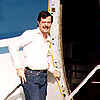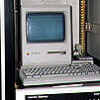 Milo Medin
is best known in the Internet community as one of the
developers of
Open Shortest Path First
(OSPF), the new and improved dynamic routing protocol. He also runs the
NASA Science
Internet
(NSI), one of the largest operational networks and one of
the core backbones for the Internet.
Milo Medin
is best known in the Internet community as one of the
developers of
Open Shortest Path First
(OSPF), the new and improved dynamic routing protocol. He also runs the
NASA Science
Internet
(NSI), one of the largest operational networks and one of
the core backbones for the Internet.
NASA Ames Research Center, where Milo worked, is located at the Moffet Naval Air Station near Mountain View, the site of an impressive collection of wind tunnels that includes one big enough to fit a full-size Boeing 727. Another tunnel can achieve hypersonic speeds of Mach 9. The big tunnel is powered by six 28,000 horsepower engines and takes so much power that it can only be run at night (after first warning the power company).
NSI links all the big NASA laboratories, such as Ames, the Jet Propulsion Laboratory, Goddard in Maryland, and the Kennedy Space Center in Florida. It also links scientists in universities and at research facilities in locations as diverse as the Antarctic, Greenland, and Easter Island.
NSI is both a general-purpose Internet and a mission-oriented operational network. As a mission-oriented network, NSI has some fascinating applications with demanding resource requirements.
For example, a telescope at Owens Valley is connected to NSI, allowing astronomers to reposition the telescope remotely. Another set of applications distribute data from the Upper Atmospheric Research Satellite, moving telemetry data from the satellite to White Sands. From there, the data are moved to Goddard's Consolidated Data Handling Facility, where they are distributed over NSI to remote analysis centers.
Perhaps the most unusual application I saw was a C141 airplane used for infra-red data collection. The plane regularly flies between Ames and Christchurch, New Zealand. The plane has its own Class C network address and is filled with Sparcstations on an Ethernet.
The plane flies its route and collects data along the way. When it lands, a thinwire BNC connection drops out of the back and connects to a cable in the hanger, making the plane a part, once again, of NSI. The movement of the plane from one facility to another is transparent to users. Routing protocols, such as OSPF and EGP, are used to announce the availability of the plane network to the rest of the Internet.
Keeping 70 routers, plus underwater fiber, satellite, and dozens of high-bandwidth terrestrial links up and running is quite a challenge. In many cases, the links not only have to be up but also need to provide adequate performance for the transfer of large images or low latency delivery of operational commands.
The network is managed from within a Network Control Center at Ames. The current status of the network is shown on a wall display, with bad links in red and good ones in green. Operators at workstations monitor these links 24 hours per day.
Given Milo's active IETF involvement, it is not surprising that SNMP is used extensively to monitor network status. SNMP, however, provides in-band network management and does not help very much when the network was down. To supplement SNMP, each of the routers in the NSI network has a modem on the console port, allowing operators at the Network Control Center to dial in and diagnose problems, often while the users on-site sleep.
While TCP/IP is the main protocol suite in NSI, there is also a heavy DECnet contingent. Unlike TCP/IP, DECnet Phase IV has no globally administered address space. The architecture assumes a single network which has up to 63 areas, each area under some management entity.
When a global community starts to interconnect, as in the case of space sciences or physics, you quickly get many more than 63 areas. DEC had a hard time believing that physicists would need more than 63 areas. "Just get organized," they would say.
"Just get expletized," the physicists would respond.
To solve the problem, groups like NSI and HEPnet have been forced to resort to hidden areas. NSI and HEPnet agreed to make areas 1 to 46 globally administered areas, available to the entire physics and space sciences DECnet communities. These areas mean the same thing to all routers in NSI. CERN, for example, used area 22 under DECnet Phase IV and area 23 for Phase V migration.
Areas between 47 and 63 are reusable. A particular DECnet router would know about one of these areas, but another router in the network might use that same area number for a totally different network.
On many links, DECnet and TCP/IP had equal status, being sent across by multiprotocol routers. Occasionally, for political or technical reasons, the underlying link could only transfer TCP/IP traffic. A process known as "tunneling" encapsulates DECnet traffic inside of IP packets, making two DECnet routers appear to be next to each other.
NSI is both a special-purpose network and a general-purpose Internet. Owning the links means that NSI is able to control them, helping to tune the network for the bandwidth and latency requirements of specific end-to-end requirements. This doesn't mean that the network is isolated, only that NSI planners have a fairly good idea of what is happening on their part of the Internet.
NSI also acts as one of the Internet backbones. Links to New Zealand, Hong Kong, Australia, Hawaii, London, and many other sites come in at NASA Ames, Goddard, or other NSI sites. The data from these sites is routed on through to its final destination, which might well be outside of NSI.
One of the key links into the rest of the Internet, indeed one of the two key hubs in the entire internetwork, is at Ames. This is the Federal Internet Exchange for the West coast, known as FIX West. The other FIX is in College Park, Maryland, and is called Fix East.
FIX West is located in a small squat building in the middle of a sweet potato patch on the edge of Ames. The building is shared by NSI and the NASA Telephone Company, which maintains the underlying bandwidth on which NSI runs.
Inside the windowless building, Pacific Bell has the termination for 12 fiber optic cables. Two other sets of 12 fibers terminate at other locations on site to provide redundancy. The fiber provides 30 to 40 T1 links, but could easily provide as much as a dozen OC-3 links running at 155 Mbps each.
The room is packed with termination equipment, patch panels, and other telesoterica. In a locked wire cage are all the routers for NSI. One 19 inch rack holds routers for the Bay Area Research Network (BARRnet). Another has NSS routers for the NSFnet. Other racks hold equipment for local networks, such as the link to the huge National Aerodynamic Simulation center at Ames. Yet more racks have routers for the Energy Sciences network (ESnet), NSI, and many others.
 In a corner is a huge, antique piece of equipment, known as a
Butterfly.
The Butterfly is made by BBN and is still used by MILNET as a "Mailbridge" to the outside world. Prying off the top of
this ancient-looking device, Milo showed me the Macintosh hidden
inside which is used as the console.
In a corner is a huge, antique piece of equipment, known as a
Butterfly.
The Butterfly is made by BBN and is still used by MILNET as a "Mailbridge" to the outside world. Prying off the top of
this ancient-looking device, Milo showed me the Macintosh hidden
inside which is used as the console.
Also located in this building are the electronics for two complete C band satellite earth stations, not to mention videoconferencing equipment, racks for the experimental Terrestrial Wideband network, time servers, and a host of other equipment needed to provide the gateway for the west coast, the Pacific Rim, and much of the rest of the Internet.
Finishing what Milo called the "cheap tour," we drove by the huge hangers of Moffet Field, originally built to house dirigibles and so immense that clouds form inside when the doors are closed. Milo stopped at another hanger, where we saw Harriers, Hornets, U2s, and many other NASA aircraft being worked on. The U2s were used to pinpoint firestorm centers during the Yellowstone fires, helping the firefighters to identify targets.
After a nice lunch of generic Chinese food, I borrowed a terminal to read my mail. Being in the center of the world, I figured my response time ought to be good, and it certainly was.
Heading out, I stopped first at the visitors center. Here you can get all sorts of educational books on atmospheric sciences and scale models of historic aircraft. I headed straight for the astronaut food, where I bought five pouches of freeze-dried, vacuum-packed ice cream, a chalky, marshmallow-like bar that sort of resembles ice cream if you freeze it and squint your eyes.